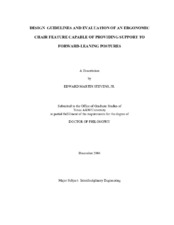| dc.description.abstract | This research investigated the need, design, and evaluation of a product capable of providing support to forward-leaning postures. Due to the high occurrence of low-back pain in industry potentially due to workers performing their tasks while assuming forward-leaning postures, along with the biological plausibility of these postures causing low-back pain, the need was established for a product that provides forward-leaning support. An envelope was quantified, ranging from the 5th percentile female to the 95th percentile male, to establish the range of potential forward-leaning postures. The design of a Support-Arm for use with current ergonomic chairs was discussed and design feature specifications were then provided. A Latin Square statistical design was employed to evaluate a Support-Arm model alongside 8 other commonly used chairs over 3 different postures. Subjects, overall, had lower peak pressures for the buttock-thigh region, increased productivity, higher comfort levels, and higher buttock-thigh contact areas when seated in the Support-Arm model chair as compared to the other chairs. Subjects, overall, also ranked this chair first over the other chairs for preferred use after having sitting experience in all 9 chairs. In an additional part of the evaluation, subjects chose their own set-up of the Support-Arm model chair. Eleven of the 18 subjects chose to use the Support-Arm when their workstation was located 36” above the floor. Subjects confirmed the need to design a Support-Arm capable of providing forward leaning support to the entire envelope of forward-leaning postures. Statistical evaluation revealed several significant differences between the chairs. The results gave no indication that the use of a Support-Arm for forward-leaning support may cause detrimental effects to users or overall chair ergonomics. Future research could track workers’ use of a Support-Arm in industry and compare their occurrence of low-back pain to a control group. | en |


